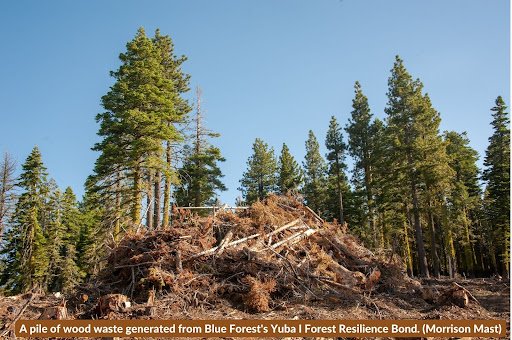Cultivating value from non-merchantable biomass through biochar and carbon credit production


According to a recent report by Blue Forest, Climate Action Reserve, Pacific Biochar, and UC Berkeley, a new climate-friendly alternative is on the rise that utilizes woody biomass to simultaneously produce biochar and high-quality carbon credits.
Written by: Clare Loughlin, Communications Associate
Forest management, particularly fuel thinning, produces millions of tonnes of woody biomass every year. This biomass is often piled and burned or left to decompose—the cheapest forms of disposal. According to a recent report by Blue Forest, Climate Action Reserve, Pacific Biochar, and UC Berkeley, a new climate-friendly alternative is on the rise that utilizes woody biomass to simultaneously produce biochar and high-quality carbon credits.
Biochar is produced by the burning of organic matter, commonly known as “biomass,” in a low-oxygen environment, a process called pyrolysis. This process transforms plant material into a porous, stable form of carbon that can be added to nutrient-depleted soils to improve soil fertility. Biochar stores carbon removed from the atmosphere during photosynthesis by plants, which helps mitigate climate change and provides the opportunity for biochar producers to earn carbon credits.
Biochar generates highly-valued carbon credits
Carbon credits are measurable, verifiable units that correspond to carbon eliminated from the environment. One carbon credit is equivalent to one ton of carbon dioxide removed from or prevented from entering the atmosphere. According to Blue Forest Co-Founder and Chief Scientist Phil Saksa, PhD, “Biochar is one of the most stable forms of carbon storage that exists. As a result, carbon credits generated from the production of biochar are some of the most highly valued credits in the marketplace.” Instead of the market rate of US$5-20 per carbon credit, credits from biochar can realize a value exceeding US$100 per credit. The potential for biochar to earn carbon credits is a recent development. In 2020, Pacific Biochar, a co-author of the report, was one of the first companies to earn carbon credits for its production of biochar.
As forest thinning and fuels reduction ramp up across the American West to reduce the risk of severe wildfire, there is new opportunity to utilize wood waste as a potential feedstock for biochar production. Between 4 and 18 million tonnes of biomass is generated annually in the Western U.S. from needed forest restoration projects such as forest thinning. This equates to a potential 1-4 million tonnes of biochar and 2-11 million carbon credits, depending on the end use market. The potential for co-production of biochar and carbon credits is promising.
There are other climate beneficial products that can be made from non-merchantable woody biomass, but the lack of effective supply chains remains a problem. Micah Elias, Research Fellow at Blue Forest and PhD Candidate at UC Berkeley says, “Biochar production provides an opportunity to develop much-needed supply chains for low value biomass generated during forest management. Once supply chains are developed, investment can more easily flow into the production of biochar and other products such as hydrogen which can use large amounts of low value biomass.”
Biochar can be used as a soil amendment
In addition to sequestering carbon, biochar can be used as a soil amendment, generating value and improving soil fertility. Producing biochar through pyrolysis involves exposing plant matter to heat over time to produce biochar that increases water-holding and nutrient retention capacity of the soil. As a soil amendment, these properties can translate into increased crop yields, a reduction in fertilizer and irrigation needs, and a decrease in water and nutrient leaching from soils (reducing nutrient pollution).
The specific physical and chemical properties of biochar depend on the original plant material but can be manipulated to meet the needs of specific crops, soils, or substrates based on the temperature and length of exposure to heat during pyrolysis. As mentioned in the report, high value crops such as pistachio, wine grapes, and almonds significantly benefit from biochar applications.
The co-production of biochar and carbon credits presents a large potential for profitability
The report further analyzed the potential profitability and market value of carbon credits and biochar production from wood waste generated from forest restoration. Large scale utilization of non-merchantable forest biomass as a feedstock for biochar production will be made possible by transparent and consistent feedstock supply chains coupled with 1) high carbon market prices, 2) a subsidy or other price mechanism to lower feedstock costs, or 3) economies of scale.
Key findings:
-
Approximately 210,000 tonnes of biochar could be produced annually with intensive upgrades to the California biopower facilities and 340,000 tonnes with upgrades to facilities throughout the West. This corresponds to potential carbon credit generation of up to 570,000 credits per year in California and 930,000 credits annually throughout the West.
-
Voluntary carbon offsets will sustain current prices around US$100 as long as biochar credits remain niche and quality conscious buyers are concerned with durability and quality.
-
Agricultural soil amendments provide the potential for biochar end use markets. Biochar applications can provide economic returns in as little as two harvests.
-
The potential supply of biochar for soil applications is over three billion tonnes.
-
US$100 million in investments in biochar production systems could generate up to four million carbon credits over 10 years and investments between US$20-$50 billion could utilize all of the non-merchantable forest biomass generated from forest restoration.
-
Large scale utilization of non-merchantable forest biomass as a feedstock for biochar production will be made possible by transparent and consistent feedstock supply chains coupled with 1) high carbon market prices, 2) a subsidy or other price mechanism to lower feedstock costs, or 3) economies of scale.
Check out the report to learn more.
This work was supported in part by the Doris Duke Charitable Foundation to Blue Forest and the U.S. Forest Service Wood Innovation Program to the Climate Action Reserve & Blue Forest. Blue Forest and the Climate Action Reserve are equal opportunity providers.